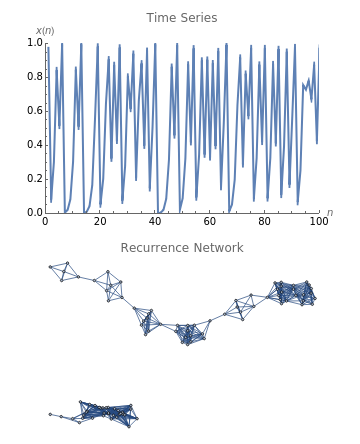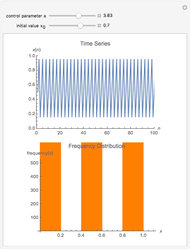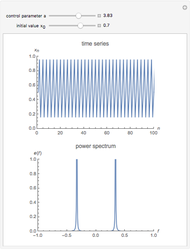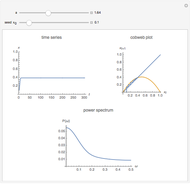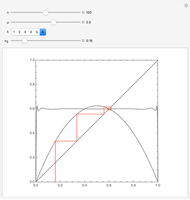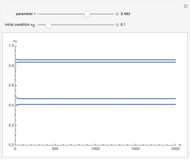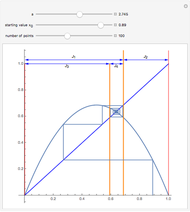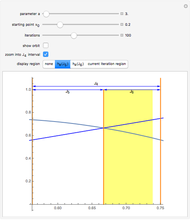Recurrence-Based Representations of the Logistic Map

Requires a Wolfram Notebook System
Interact on desktop, mobile and cloud with the free Wolfram Player or other Wolfram Language products.
Recurrence plots and recurrence networks are complementary representations of the recurrence properties of a time series. Every time step constitutes a node of the recurrence network. A recurrence in phase space is either represented by a link in the recurrence network or as a black dot in the recurrence plot. Two time steps are recurrent if and only if their mutual distance is smaller than a threshold  .
.
Contributed by: Alraune Zech, Jonathan F. Donges, Norbert Marwan, and Jürgen Kurths (February 2010)
Open content licensed under CC BY-NC-SA
Snapshots
Details
A recurrence network (undirected and unweighted) is represented by a binary adjacency matrix  , where
, where  if nodes
if nodes  and
and  are linked, and
are linked, and  otherwise. Two nodes are considered to be linked when their mutual distance is smaller than
otherwise. Two nodes are considered to be linked when their mutual distance is smaller than  The adjacency matrix is then given by
The adjacency matrix is then given by  , where
, where  if
if  and
and  otherwise.
otherwise.
The adjacency matrix is related to the recurrence matrix  representing a recurrence plot (RP) by
representing a recurrence plot (RP) by  .
.
The recurrence network view allows us to apply the methods and measures of complex network theory to time series analysis. It is complementary to the traditional recurrence quantification analysis based on line structures in recurrence plots.
Snapshot 1 ( ): in the periodic regime, with period length
): in the periodic regime, with period length  , the phase space consists of three (nearly) fully connected network components
, the phase space consists of three (nearly) fully connected network components
Snapshot 2 ( ): at the band-merging point, the RP reveals extended clusters of recurrence points, which correspond to many laminar phases; moreover, several diagonal lines appear, showing short epochs of similar evolution of states
): at the band-merging point, the RP reveals extended clusters of recurrence points, which correspond to many laminar phases; moreover, several diagonal lines appear, showing short epochs of similar evolution of states
Snapshot 3 ( ): the RP for laminar states also consists of extended clusters, but possesses more diagonal lines
): the RP for laminar states also consists of extended clusters, but possesses more diagonal lines
Snapshot 4 ( ): for the outer crisis a giant component still exists, but the nodes are less tightly clustered than in the previous snapshots
): for the outer crisis a giant component still exists, but the nodes are less tightly clustered than in the previous snapshots
This Demonstration was created during an internship at the Potsdam Institute for Climate Impact Research, Germany. It is based on the articles:
[1] N. Marwan, J. F. Donges, Y. Zou, R. V. Donner, and J. Kurths, "Complex Network Approach for Recurrence Analysis of Time Series," Physics Letters A, 373(46), 2009 pp. 4246–4254.
[2] R. V. Donner, Y. Zou, J. F. Donges, N. Marwan, and J. Kurths, "Recurrence Networks - A Novel Paradigm for Nonlinear Time Series Analysis," arXiv, 2009.
[3] R. V. Donner, Y. Zou, J. F. Donges, N. Marwan, and J. Kurths, "Ambiguities in Recurrence-Based Complex Network Representations of Time Series," Physical Review E (R), 2010.
[4] N. Marwan, N. Wessel, U. Meyerfeldt, A. Schirdewan, and J. Kurths, "Recurrence-Plot-Based Measures of Complexity and Their Application to Heart-Rate-Variability Data," Physical Review E, 66(2), 2002.
[5] N. Marwan, M. C. Romano, M. Thiel, and J. Kurths, "Recurrence Plots for the Analysis of Complex Systems," Physics Reports, 438(5–6), 2007 pp. 237–329.
Further information can be found at Recurrence Plots and Cross Recurrence Plots.
Permanent Citation
